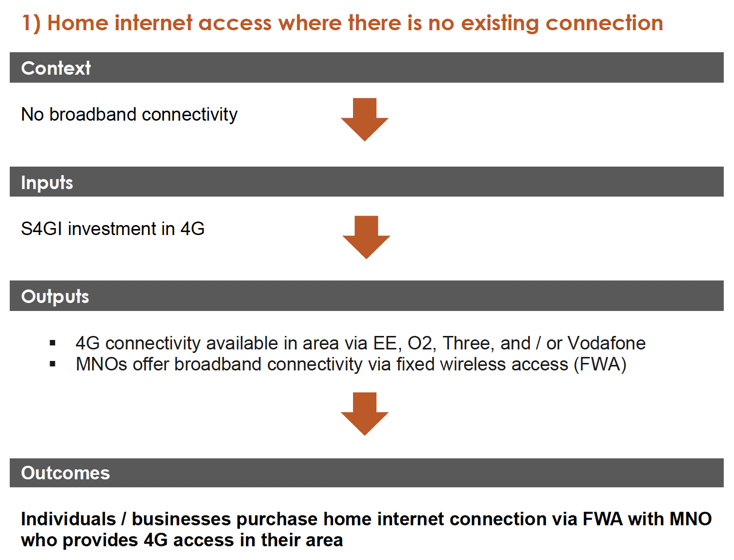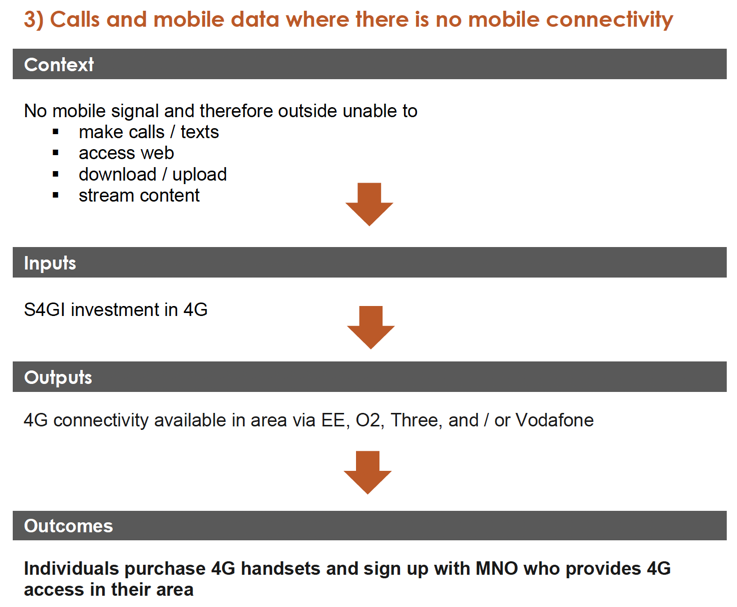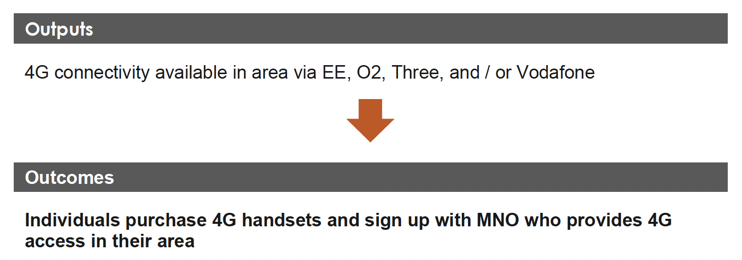Scottish 4G Infill Programme Evaluation
This report details findings of the Scottish 4G Infill Programme (S4GI) Evaluation, informed by the best practice set out in the Digital Appraisal Manual for Scotland (DAMS): https://www.gov.scot/publications/digital-appraisal-manual-for-scotland-guidance/
4 Logic Maps
4.1 Overview
4.1.1 Drawing on the benefits of enhanced digital connectivity identified within the wider literature, this chapter sets out a series of logic maps specifying the range of potential outcomes and impacts which may result from the delivery of the S4GI Programme and which should be explored within the research.
4.2 ‘Base’ Position
4.2.1 The range of potential benefits provided by the S4GI Programme will depend on each individual’s ‘base’ position with respect to both broadband availability and mobile coverage.
4.2.2 Prior to the delivery of the S4GI Programme, some individuals will have had usable mobile phone coverage for making calls and sending text messages under a 2G regime, some may have had 3G coverage offering limited internet capability, while some may have had no usable or reliable mobile connectivity at all. These levels of connectivity will also differ in-house from outside.
4.2.3 Similarly, broadband availability and speed will differ in each community. For those with decent broadband access, the key benefits will be improved mobile connectivity outside the home and the resilience benefit provided by having another means to access the internet within the home. However, for those with no broadband or unreliable broadband connectivity, the provision of 4G may also provide an opportunity for an improved internet connection within the home via an FWA connection.
4.2.4 Based on the various base positions, six categories of potential benefits can be identified. These are summarised in Table 4‑1.
Connectivity |
No broadband connectivity |
Unreliable broadband |
Decent broadband |
|---|---|---|---|
No mobile connectivity |
Home internet, mobile data, calls |
Improved home internet, calls, mobile data |
Calls, mobile data |
2G |
Home internet, mobile data |
Improved home internet, mobile data |
Mobile data |
3G |
Home internet, improved mobile data |
Improved home internet, improved mobile data |
Improved mobile data |
4.2.5 From this, five separate benefit components can be identified as follows:
1) Home internet access (where there is no existing home connection)
2) Improved home internet access (where the existing home connection is unreliable)
3) Calls and mobile data (where there is no mobile connectivity currently)
4) Mobile data (where there is 2G connectivity currently)
5) Improved mobile data (where there is 3G connectivity currently)
4.2.6 Of these, 2) replicates the outputs, outcomes, and impacts provided by 1) but to a lesser degree and 5) replicates the outputs, outcomes, and impacts provided by 4) but to a lesser degree. Given this, three logic maps setting out the potential outputs, outcomes, and impacts of the change covering 1), 3) and 4) have been developed. These are set out in Figure 4‑1 to Figure 4‑3.
4.2.7 The main components of the logic maps and include:
- Context: The problems and opportunities which S4GI is seeking to address. This effectively forms the rationale for proceeding with the S4GI i.e., the case for change which underpins the business case.
- Input: The investment and processes required to deliver S4GI.
- Outputs: The direct deliverable(s) from S4GI i.e. the improvement in connectivity provided.
- Outcomes: Changes in behaviour which result from the changes in connectivity (outputs).
- Impacts: Societal changes which occur as a consequence of the changes in connectivity (outputs) and the changes in behaviour (outcomes) which stem from the intervention, e.g., reduced economic inactivity / unemployment, higher productivity, land-value uplift etc.
4.2.8 It is important to recognise that outputs, outcomes, and impacts materialise at different times. Whilst outputs are delivered upon project completion or once the investment is operational, outcomes and impacts take longer to materialise, with some longer-term impacts taking 10-15 years to become apparent. In addition, there is a time-lag in the availability of some secondary data sources for measuring outcomes and impacts with, for example, some datasets only produced every ten years in line with Census reporting periods. This acts to further extend the period between the investment being delivered and the time when it is possible to report on its full impacts.
4.2.9 Having identified the range of potential outcomes and impacts within the logic maps, the next stage is to undertake primary research in the areas affected by S4GI, in order to gather evidence of these potential changes. The next chapter sets out the methodological approach to delivering this primary research.

Residents:
- Remote working – ability to work at home
- Remote learning – access to online learning opportunities
- Personal business – access to online banking / bill paying and online health appointments
- Access to information enabling more informed decisions
- Online shopping
- Video calls with friends / family
- Entertainment – streaming channels
Visitors:
- Access to information during visit enabling more informed decisions
Personal safety
- Access to WiFi calls within the home
Local businesses
- Remote working – ability to work at home / have staff work at home where home connectivity provided
- Easier day-to-day management through access to online information and services e.g. online banking/ bill paying / booking systems etc at home
- Easier promotion via online webpage / social media
Local tourism businesses:
- Enhanced tourism offer due to broadband access (accommodation and visitor attractions)
- Promotional benefits of visitors uploading content to social media (indoors)
Local service providers:
- Local NHS services able to provide online services
Businesses / service providers based outside of the local area:
- Access to wider labour market via remote working
- Access to larger customer base (online goods / services)
Impact
Residents:
- Jobs:
- Reduced economic inactivity / unemployment
- People taking up higher paid jobs
- People working more hours
- Education
- Higher levels of educational attainment
- Improved digital skills through use
- Health:
- Earlier diagnosis / treatment
- Improved social inclusion / reduced isolation - Access to online news, social media, online gaming improves connectivity to wider world, fosters feelings of connectedness and leads to reduced loneliness
- Leisure
- Reduced leisure spend due to fewer trips / availability of online shopping vs increased leisure spend due to more visitors / higher local wages
- Tourism
- Increased visitor numbers
Local Business:
- Higher productivity / turnover
- Formation of new businesses
Community:
- Increased in-migration / reduced outmigration
- Land and property development and value impacts
- Higher levels of inward investment
- Lower levels of social deprivation
- Equalities benefit (urban V’s rural)
Reduced carbon emissions:
- Fewer trips made due to access to online resources

Residents:
- Remote learning – mobile access to online learning resources
- Personal business – mobile access to online banking / bill paying and online health appointments
- Online shopping via mobile
- Mobile access to information enabling more informed decisions
- Mobile access to geographical mapping on the move aids navigation
- Mobile access to walking / cycling OS maps
- Resilience benefit if Wifi fails (where they have broadband)
Visitors:
- Access to information enabling more informed decisions
- Access to geographical mapping on the move aids navigation
- Access to walking / cycling OS maps
Personal safety and other benefits
- Ability to make calls / share geographic location including emergency services
- Improved coverage of location systems like ‘find my phone’
Local businesses:
- Mobile workers – ability to access online resources / make calls when on the move. Particularly useful for delivery drivers / postal workers / trades people
- Easier day-to-day management through access to mobile online information and services e.g. online banking / bill paying / booking systems etc when travelling
- Easier promotion via online webpage / social media
- Resilience benefit if Wifi fails (where they have broadband)
Local tourism businesses:
- Enhanced tourism offer due to ability to make calls / enhanced mobile connectivity (accommodation and visitor attractions)
- Promotional benefits of visitors uploading content to social media (outdoors)
- Resilience benefit if Wifi fails (where they have broadband)
Local service providers:
- Local NHS services able to provide online services
- Staff able to access online resources / make calls when outside – particularly useful for those working in community (e.g. community nurses / midwifes / health visitors / home carers)
Businesses / service providers based outside of the local area:
- Access to a larger customer base (online goods / services)
Impact
Residents:
- Jobs:
- Reduced economic inactivity / unemployment
- People taking up higher paid jobs
- People working more hours
- Education
- Higher levels of educational attainment
- Improved digital skills through use
- Health:
- Earlier diagnosis / treatment
- Improved social inclusion / reduced isolation - Access to online news, social media, online gaming improves connectivity to wider world, fosters feelings of connectedness and leads to reduced loneliness
- Leisure
- Reduced leisure spend due to fewer trips / availability of online shopping V’s increased leisure spend due to more visitors / higher local wages
- Tourism
- Increased visitor numbers
Local Business:
- Higher productivity / turnover
- Formation of new businesses
Community:
- Increased in-migration / reduced outmigration
- Land and property development and value impacts
- Higher levels of inward investment
- Lower levels of social deprivation
- Equalities benefit (urban vs rural)
Reduced carbon emissions:
- Fewer trips made due to access to online resources
- Reduced mileage due to enhanced navigation


Residents:
- Remote learning – access to online learning resources
- Personal business – access to online banking/ bill paying and online health appointments
- Online shopping via mobile
- Access to information enabling more informed decisions
- Access to geographical mapping on the move aids navigation
- Access to walking / cycling OS maps
- Resilience benefit if Wifi fails (where they have broadband)
Visitors:
- Access to information enabling more informed decisions
- Access to geographical mapping on the move aids navigation
- Access to walking / cycling OS maps
Personal safety and other benefits:
- Ability to make calls when in locations with no mobile connectivity
- Ability to share geographic location with emergency services when in locations with 2G / 3G connectivity
- Improved coverage of location systems like ‘find my phone’
Local businesses:
- Mobile workers – ability to access online resources when outside. Particularly useful for delivery drivers / postal workers
- Easier day-to-day management through access to online information and services e.g. online banking/ bill paying / booking systems etc when travelling
- Resilience benefit if Wifi fails (where they have broadband)
Local tourism businesses:
- Enhanced tourism offer due to enhanced mobile connectivity (accommodation and visitor attractions) Promotional benefits of visitors uploading content to social media (outdoors)
- Easier promotion via online webpage / social media
- Resilience benefit if Wifi fails
Local service providers:
- Local NHS services able to provide online services
- Staff able to access online resources when outside – particularly useful for those working in community (e.g. community nurses / midwifes / health visitors / home carers)
Businesses / service providers based outside of the local area:
- Access to larger customer base (online goods and services)
Impact
Residents:
- Jobs:
- Reduced economic inactivity / unemployment
- People taking up higher paid jobs
- People working more hours
- Education
- Higher levels of educational attainment
- Improved digital skills through use
- Health:
- Earlier diagnosis / treatment
- Improved social inclusion / reduced isolation - Access to online news, social media, online gaming improves connectivity to wider world, fosters feelings of connectedness and leads to reduced loneliness
- Leisure
- Reduced leisure spend due to fewer trips / availability of online shopping vs increased leisure spend due to more visitors / higher local wages
Local Business:
- Higher productivity / turnover
- Formation of new businesses
Community:
- Increased in-migration / reduced outmigration
- Land and property development and value impacts
- Higher levels of inward investment
- Lower levels of social deprivation
- Equalities benefit (urban V’s rural)
Reduced carbon emissions:
- Fewer trips made due to access to online resources
- Reduced mileage due to enhanced navigation
Contact
Email: sean.murchie@gov.scot
There is a problem
Thanks for your feedback